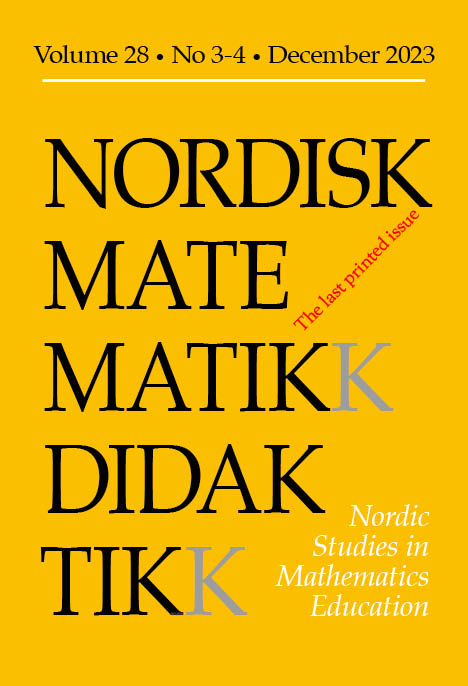Analysing mathematical programming schemes using different lenses
DOI:
https://doi.org/10.7146/nomad.v28i3-4.149268Abstract
The use of programming in mathematics education is undergoing a renaissance and, in this paper, we analyse students’ handling of programming in mathematics using the Instrumental approach as a theoretical lens. We are especially interested in analysing the development of mental schemes using two analytical frameworks which are compared and contrasted according the idea of networking theories. The study illustrates that the frameworks’ detail of richness can have both advantages and disadvantages and that one of the frameworks are more customed to be applied when analysing students’ instrumental genesis concerning the use of a programming environment as a mathematical artefact.
References
Artigue, M. (2002). Learning mathematics in a CAS environment: the genesis of a reflection about instrumentation and the dialectics between technical and conceptual work. International Journal of Computers for Mathematical Learning, 7 (3), 245-274. https://doi.org/10.1023/A:1022103903080
Bocconi, S., Chioccariello, A. & Earp, J. (2018). The Nordic approach to introducing computational thinking and programming in compulsory education. Report prepared for the Nordic@BETT2018 Steering Group. doi: 10.17471/54007
Borg, A. (2021). Designing for the incorporation of programming in mathematical education : programming as an instrument for mathematical problem solving [Licentiate thesis]. Karlstads University. http://urn.kb.se/resolve?urn=urn:nbn:se:kau:diva-85625
Bråting, K. & Kilhamn, C. (2021). Exploring the intersection of algebraic and computational thinking. Mathematical Thinking and Learning, 23 (2), 170-185. https://doi.org/10.1080/10986065.2020.1779012
Buteau, C., Gueudet, G., Muller, E., Mgombelo, J. & Sacristán, A. I. (2020). University students turning computer programming into an instrument for "authentic" mathematical work. International Journal of Mathematical Education in Science and Technology, 51 (7), 1020-1041. https://doi.org/10.1080/0020739X.2019.1648892
Buteau, C., Muller, E., Mgombelo, J., Sacristán, A. I. & Dreise, K. (2020). Instrumental genesis stages of programming for mathematical work. Digital Experiences in Mathematics Education, 6 (3), 367-390. https://doi.org/10.1007/s40751-020-00060-w
Drijvers, P., Godino, J. D., Font, V. & Trouche, L. (2013). One episode, two lenses. Educational Studies in Mathematics, 82 (1), 23-49. https://doi.org/10.1007/s10649-012-9416-8
Drijvers, P. & Gravemeijer, K. (2005). Computer algebra as an instrument: examples of algebraic schemes. In D. Guin, K. Ruthven & L. Trouche (Eds.), The didactical challenge of symbolic calculators: turning a computational device into a mathematical instrument (pp. 163-196). Springer. https://doi.org/10.1007/0-387-23435-7_8
Drijvers, P. & Trouche, L. (2008). From artifacts to instruments: a theoretical framework behind the orchestra metaphor. In K. Heid & G. Blume (Eds.), Research on technology and the teaching and learning of mathematics (pp. 363-392). Information Age.
Elicer, R. & Tamborg, A. L. (2021). Nature of the relations between programming and computational thinking and mathematics in Danish teaching resources. Paper presented at ICTMT 15, Copenhagen.
Fahlgren, M. (2017). Redesigning task sequences to support instrumental genesis in the use of movable points and slider bars. The International Journal for Technology in Mathematics Education, 24 (1), 3-15. https://doi.org/10.1564/tme_v24.1.01
Gueudet, G., Bueno-Ravel, L., Modeste, S. & Trouche, L. (2018). Curriculum in France: a national frame in transition. In D. R. Thompson, M. A. Huntley & C. Suurtamm (Eds.), International perspectives on mathematics curriculum (pp. 41-70). Information Age.
Gueudet, G., Buteau, C., Muller, E., Mgombelo, J. & Sacristán, A. I. (2020). Programming as an artefact: What do we learn about university students' activity? In T. Hausberger, M. Bosch & F. Chellougui (Eds.), INDRUM2020 Proceedings (pp. 443-452). University of Carthage and INDRUM.
Haspekian, M. (2005). An "Instrumental approach" to study the integration of a computer tool into mathematics teaching: the case of spreadsheets. International Journal of Computers for Mathematical Learning, 10 (2), 109-141. https://doi.org/10.1007/s10758-005-0395-z
Kallia, M., van Borkulo, S. P., Drijvers, P., Barendsen, E. & Tolboom, J. (2021). Characterising computational thinking in mathematics education: a literature-informed Delphi study. Research in Mathematics Education, 1-29. https://doi.org/10.1080/14794802.2020.1852104
Noss, R. (1986). Constructing a conceptual framework for elementary algebra through Logo programming. Educational Studies in Mathematics, 17 (4), 335- 357. https://doi.org/10.1007/BF00311324
Papert, S. (1980). Mindstorms: children, computers, and powerful ideas. Basic Books.
Prediger, S., Bikner-Ahsbahs, A. & Arzarello, F. (2008). Networking strategies and methods for connecting theoretical approaches: first steps towards a conceptual framework. ZDM, 40 (2), 165-178. https://doi.org/10.1007/s11858-008-0086-z
Rabardel, P. (2002). People and technology: a cognitive approach to contemporary instruments. https://hal.archives-ouvertes.fr/hal-01020705
Resnick, M., Maloney, J., Monroy-Hernández, A., Rusk, N., Eastmond, E. et al. (2009). Scratch: programming for all. Communications of the ACM, 52 (11), 60-67. https://doi.org/10.1145/1592761.1592779
Ruthven, K. (2002). Instrumenting mathematical activity: reflections on key studies of the educational use of computer algebra systems. International Journal of Computers for Mathematical Learning, 7 (3), 275-291. https://doi.org/10.1023/A:1022108003988
Sangwin, C. J. & O'Toole, C. (2017). Computer programming in the UK undergraduate mathematics curriculum. International Journal of Mathematical Education in Science and Technology, 48 (8), 1133-1152. https://doi.org/10.1080/0020739X.2017.1315186
Sutherland, R. (1994). The role of programming: towards experimental mathematics. In R. Biehler, R. W. Scholz, R. Sträßer & B. Winkelmann (Eds.), Didactics of mathematics as a scientific discipline (pp. 177-187). Springer.
Trouche, L. (2005). An instrumental approach to mathematics learning in symbolic calculators environments. In D. Guin, K. Ruthven & L. Trouche (Eds.), The didactical challenge of symbolic calculators: turning a computational device into a mathematical instrument (pp. 137-162). Springer. https://doi.org/10.1007/0-387-23435-7_7
Turgut, M. & Drijvers, P. (2021). Instrumentation schemes for solving systems of linear equations with dynamic geometry software. International Journal for Technology in Mathematics Education, 28 (2), 65-80. https://doi.org/10.1564/tme_v28.2.01
Vergnaud, G. (1998). A comprehensive theory of representation for mathematics education. The Journal of Mathematical Behavior, 17 (2), 167-181. https://doi.org/10.1016/S0364-0213(99)80057-3
Vergnaud, G. (2009). The theory of conceptual fields. Human Development, 52 (2), 83-94. https://doi.org/10.1159/000202727
Wing, J. M. (2006). Computational thinking. Communications of the ACM, 49 (3), 33-35. https://doi.org/10.1145/1118178.1118215
Downloads
Published
How to Cite
Issue
Section
License

This work is licensed under a Creative Commons Attribution-NonCommercial-ShareAlike 4.0 International License.



